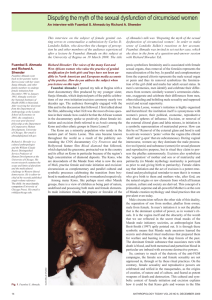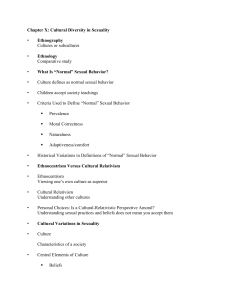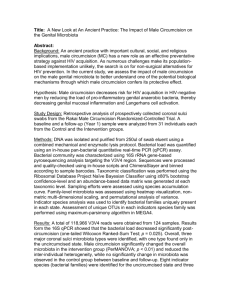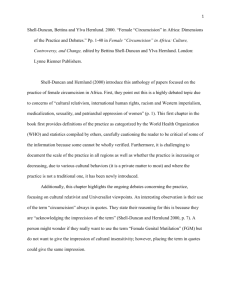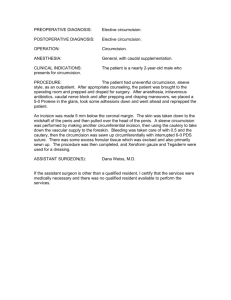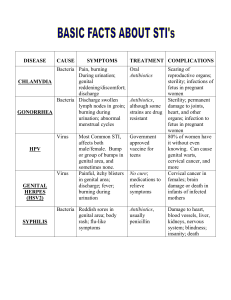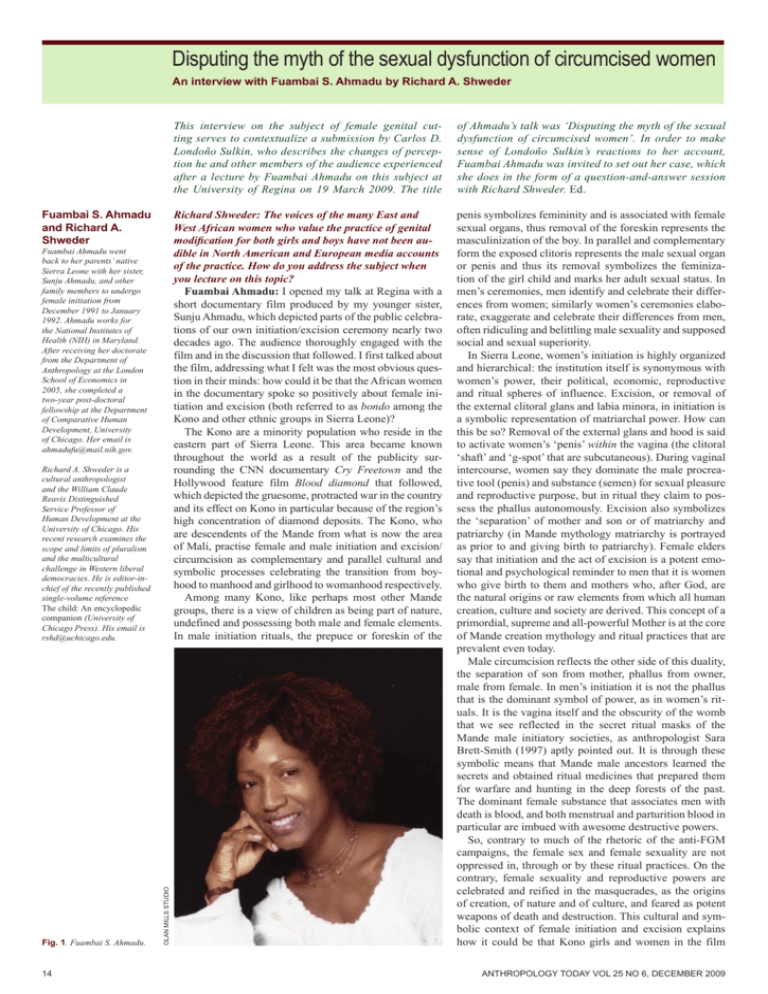
Disputing the myth of the sexual dysfunction of circumcised women
An interview with Fuambai S. Ahmadu by Richard A. Shweder
Fuambai S. Ahmadu
and Richard A.
Shweder
Fuambai Ahmadu went
back to her parents’ native
Sierra Leone with her sister,
Sunju Ahmadu, and other
family members to undergo
female initiation from
December 1991 to January
1992. Ahmadu works for
the National Institutes of
Health (NIH) in Maryland.
After receiving her doctorate
from the Department of
Anthropology at the London
School of Economics in
2005, she completed a
two-year post-doctoral
fellowship at the Department
of Comparative Human
Development, University
of Chicago. Her email is
ahmadufu@mail.nih.gov.
Fig. 1. Fuambai S. Ahmadu.
14
OLAN MILLS STUDIO
Richard A. Shweder is a
cultural anthropologist
and the William Claude
Reavis Distinguished
Service Professor of
Human Development at the
University of Chicago. His
recent research examines the
scope and limits of pluralism
and the multicultural
challenge in Western liberal
democracies. He is editor-inchief of the recently published
single-volume reference
The child: An encyclopedic
companion (University of
Chicago Press). His email is
rshd@uchicago.edu.
This interview on the subject of female genital cutting serves to contextualize a submission by Carlos D.
Londoño Sulkin, who describes the changes of perception he and other members of the audience experienced
after a lecture by Fuambai Ahmadu on this subject at
the University of Regina on 19 March 2009. The title
of Ahmadu’s talk was ‘Disputing the myth of the sexual
dysfunction of circumcised women’. In order to make
sense of Londoño Sulkin’s reactions to her account,
Fuambai Ahmadu was invited to set out her case, which
she does in the form of a question-and-answer session
with Richard Shweder. Ed.
Richard Shweder: The voices of the many East and
West African women who value the practice of genital
modification for both girls and boys have not been audible in North American and European media accounts
of the practice. How do you address the subject when
you lecture on this topic?
Fuambai Ahmadu: I opened my talk at Regina with a
short documentary film produced by my younger sister,
Sunju Ahmadu, which depicted parts of the public celebrations of our own initiation/excision ceremony nearly two
decades ago. The audience thoroughly engaged with the
film and in the discussion that followed. I first talked about
the film, addressing what I felt was the most obvious question in their minds: how could it be that the African women
in the documentary spoke so positively about female initiation and excision (both referred to as bondo among the
Kono and other ethnic groups in Sierra Leone)?
The Kono are a minority population who reside in the
eastern part of Sierra Leone. This area became known
throughout the world as a result of the publicity surrounding the CNN documentary Cry Freetown and the
Hollywood feature film Blood diamond that followed,
which depicted the gruesome, protracted war in the country
and its effect on Kono in particular because of the region’s
high concentration of diamond deposits. The Kono, who
are descendents of the Mande from what is now the area
of Mali, practise female and male initiation and excision/
circumcision as complementary and parallel cultural and
symbolic processes celebrating the transition from boyhood to manhood and girlhood to womanhood respectively.
Among many Kono, like perhaps most other Mande
groups, there is a view of children as being part of nature,
undefined and possessing both male and female elements.
In male initiation rituals, the prepuce or foreskin of the
penis symbolizes femininity and is associated with female
sexual organs, thus removal of the foreskin represents the
masculinization of the boy. In parallel and complementary
form the exposed clitoris represents the male sexual organ
or penis and thus its removal symbolizes the feminization of the girl child and marks her adult sexual status. In
men’s ceremonies, men identify and celebrate their differences from women; similarly women’s ceremonies elaborate, exaggerate and celebrate their differences from men,
often ridiculing and belittling male sexuality and supposed
social and sexual superiority.
In Sierra Leone, women’s initiation is highly organized
and hierarchical: the institution itself is synonymous with
women’s power, their political, economic, reproductive
and ritual spheres of influence. Excision, or removal of
the external clitoral glans and labia minora, in initiation is
a symbolic representation of matriarchal power. How can
this be so? Removal of the external glans and hood is said
to activate women’s ‘penis’ within the vagina (the clitoral
‘shaft’ and ‘g-spot’ that are subcutaneous). During vaginal
intercourse, women say they dominate the male procreative tool (penis) and substance (semen) for sexual pleasure
and reproductive purpose, but in ritual they claim to possess the phallus autonomously. Excision also symbolizes
the ‘separation’ of mother and son or of matriarchy and
patriarchy (in Mande mythology matriarchy is portrayed
as prior to and giving birth to patriarchy). Female elders
say that initiation and the act of excision is a potent emotional and psychological reminder to men that it is women
who give birth to them and mothers who, after God, are
the natural origins or raw elements from which all human
creation, culture and society are derived. This concept of a
primordial, supreme and all-powerful Mother is at the core
of Mande creation mythology and ritual practices that are
prevalent even today.
Male circumcision reflects the other side of this duality,
the separation of son from mother, phallus from owner,
male from female. In men’s initiation it is not the phallus
that is the dominant symbol of power, as in women’s rituals. It is the vagina itself and the obscurity of the womb
that we see reflected in the secret ritual masks of the
Mande male initiatory societies, as anthropologist Sara
Brett-Smith (1997) aptly pointed out. It is through these
symbolic means that Mande male ancestors learned the
secrets and obtained ritual medicines that prepared them
for warfare and hunting in the deep forests of the past.
The dominant female substance that associates men with
death is blood, and both menstrual and parturition blood in
particular are imbued with awesome destructive powers.
So, contrary to much of the rhetoric of the anti-FGM
campaigns, the female sex and female sexuality are not
oppressed in, through or by these ritual practices. On the
contrary, female sexuality and reproductive powers are
celebrated and reified in the masquerades, as the origins
of creation, of nature and of culture, and feared as potent
weapons of death and destruction. This cultural and symbolic context of female initiation and excision explains
how it could be that Kono girls and women in the film
ANTHROPOLOGY TODAY VOL 25 NO 6, DECEMBER 2009
were speaking in positive, almost reverential terms, about
the practice, their bodies and the experience of womanhood. There are different types of female genital cutting
practices that are performed for many different reasons,
and these practices prevail in diverse sociocultural contexts, so not all women who are affected necessarily support these practices or view them as empowering to girls
and women.
RS: What is your general view of the relationships
between informed anthropological and medical research on this topic and representations in the advocacy
literature which describe the practice as ‘female genital
mutilation’?
FA: The anthropological literature on this topic (prior
to the nearly universal acceptance of the term FGM in
the mid-1990s) was more nuanced and contextualized
within the dominant socio-cultural frameworks of affected
women. But what about the health risks? How could even
well-meaning anthropologists justify the medical hazards
of this practice and the sexual oppression of women as
represented by advocacy groups who see culture in this
instance as an excuse for male barbarism and domination?
The problem with the representation of various forms of
female circumcision as ‘mutilation’ is that the term, among
other things, presupposes some irreversible and serious
harm. This is not supported by current medical research
on female circumcision.
Carla Obermeyer (1999, 2003), who was a consultant for
WHO, published two comprehensive and critical reviews.
The first looked at the available literature on female circumcision up to 1996, the second from 1997 to 2002. Her
conclusion is as follows: ‘On the basis of the vast literature
on the harmful effects of genital surgeries, one might have
anticipated finding a wealth of studies that documents considerable increases in mortality and morbidity. This review
could find no incontrovertible evidence on mortality, and
the rate of medical complications suggests that they are
the exception rather than the rule’ (Obermeyer 1999: 92)
Another major source, which contradicts received
notions about the health hazards of excision in particular,
is a study by Linda Morison et al. (2001) at the UK’s
Medical Research Council Laboratories located in Fajara,
The Gambia. Widely cited as authoritative in the literature, this research is the most systematic, comprehensive
and controlled investigation of the health consequences of
female circumcision yet to be conducted. In summary, the
study found that the supposed morbidities often cited as
common problems associated with excision (such as infertility, painful sex, vulval tumours, menstrual problems,
incontinence and most endogenous infections) did not distinguish women who had the surgery from those who did
not. The rate of infertility was exactly the same for both
groups – 10%. The authors noted additionally that women
expressed high levels of support for the practice.
However, neither Obermeyer’s reviews nor the Morison
et al. study have been mentioned in any major Western
press, despite their startling and counter-intuitive findings
on female circumcision and health. This is in contrast to
the highly publicized Lancet report by the WHO Study
Group on FGM, released in June 2006, which received
widespread, immediate and sensationalized press coverage
highlighting claims about infant and maternal mortality
during hospital birth. As Bettina Shell-Duncan (2008)
pointed out, the New York Times unquestioningly sensationalized this group’s findings under the heading: ‘Genital
cutting raises by 50% likelihood that mothers or their newborns will die, study finds’ (Rosenthal 2006). Shell-Duncan
notes that what this shocking headline failed to mention is
the modest magnitude of risk. Another observer noted that,
in comparing risk factors in pregnancy, this places female
circumcision somewhere behind maternal smoking.
ANTHROPOLOGY TODAY VOL 25 NO 6, DECEMBER 2009 I would note that in the extended New York Times
Tierneylab blog1 discussion of this topic you [Shweder]
also questioned the findings of the WHO Lancet study and
its purported evidence of increased ‘harm’ for circumcised
women. You noted that the study collected data on women
across six nations but never displayed the results for individual nations to see if they could be replicated; there was
no direct control for the quality of health care available for
‘circumcised’ versus ‘uncircumcised’ women; the sample
was unrepresentative of the whole population; and even
given the evidence presented, any risk of genital surgery
was astonishingly small and hardly a mandate for an eradication rather than a public health programme.
Sweden-based studies conducted by Birgitta Essen, an
obstetrician, and by Sara Johnsdotter, a medical anthropologist, are worthy of mention (Johnsdotter and Essen 2004,
Birgitta Essen et al. 2002, 2005). In Essen et al. 2002 no
evidence was found of causal connection between genital
surgeries and obstructed or prolonged labour. Essen et al.
(2005) concluded, surprisingly, that circumcised women
were at a lower risk of prolonged labour as compared with
uncircumcised Swedish women.
Another obstetrician/gynaecologist, Crista Johnson
(2008), who attends to a large number of Somali immigrant patients, has pointed out that the risk of still births
may be particularly increased for circumcised women who
delay prenatal care and getting to hospitals when they are
experiencing complications because they fear being stigmatized by healthcare workers, and because these workers
lack specialized knowledge of these women’s bodies. In
other words, could it be the low standard of care circumcised women are receiving, and fears on the part of both
affected women and healthcare providers in zero-tolerance
and anti-FGM environments, that contribute to small differences in infant mortality rates in the Lancet study?
So, even if the purported negative health outcomes have
been exaggerated and circumcised women rightly have
their own fears about the risks of being uncircumcised,
how can they justify excision of the very sensitive tissue
that makes up the clitoris? As some concerned students
have asked me, isn’t this tantamount to castration?
It has somehow become ubiquitous and obvious knowledge that female circumcision is intended to and actually
does inhibit female sexual desire and feeling and that it is
like cutting off the male penis, an analogy I never quite
understood. But what is the research evidence on female
circumcision and sexual pleasure? Obermeyer (1999:55)
stated in her review that: ‘studies that systematically
investigate the sexual feelings of women and men in
societies where genital surgeries are found are rare, and
the scant information available calls into question the
assertion that female genital surgeries are fundamentally
antithetical to women’s sexuality and incompatible with
sexual enjoyment.’
In addition to my own research in the Gambia (Ahmadu
2007), there are several important texts on this issue. The
first paper was published by an ardent and vocal anti-FGM
activist, Hanny Lightfoot-Klein, the author of Prisoners
of ritual, a seminal work for anti-FGM advocates. In her
article, Lightfoot-Klein (1989) challenges whether infibulation, the most extreme form of female circumcision, is
inimical to women’s enjoyment of sex and experience of
orgasm. According to her five-year research, 94% of circumcised women reported sexual satisfaction and orgasm
and many said they had sex three or four times a week.
So what was the problem for Lightfoot-Klein? Sudanese
women, in her view, are completely subjugated by their
husbands and have no authority whatsoever or agency over
their own bodies. But I see a disturbing problem with the
implications of this picture: how is that so-called mutilated
African women are at one and the same time subjugated by
15
SUNJU AHMADU
Fig. 2. A still from Bondo:
A journey into Kono
womanhood, a documentary
by Sunju Ahmadu. Following
an assertion by a Freetownbased Nigerian doctor
and anti-FGM activist,
that African women do not
understand ‘wellness’ and
think that sexual intercourse
is only for reproduction, two
young Kono girlfriends, one
excised and one not, discuss
their personal experiences
and beliefs about whether
excision affects sexual
pleasure. The excised woman
expresses confidence in her
ability to experience complete
and even greater sexual
fulfilment than her unexcised
friend, and reaffirms her
pride in being a bondo
initiate.
their husbands and also enjoying sex with these patriarchal
oppressors and reaching orgasm several times per week?
Is it that African women are masochistic and disturbingly enjoy their own sexual subjugation? Or might this
suggest that some Westerners and feminists have it wrong
about the nature of African marriages, social systems and
male-female interactions and intimacies? If the experiences of these Sudanese women are anything like my own
and those of the community of women I was raised among,
then I doubt very much that they are somehow sexually
deviant masochists who are ignorant of and enjoy their
own oppression.
Of particular interest is a recent publication by Lucrezia
Catania (Catania et al. 2007), an Italian obstetrician and
gynaecologist who runs a clinic with her Somali husband
in Italy that is frequented by mainly Somali immigrants.
According to the study, the findings ‘suggest, without
doubt, that healthy “mutilated/circumcised” women who
did not suffer grave long-term complications and who
have a good and fulfilling relationship may enjoy sex
and have no negative impact on psychosexual life (fantasies, desire and pleasure, ability to experience orgasm)’.
Catania’s findings were also interesting in that, in comparison with her Italian control group, infibulated Somali
women reported greater frequency of orgasms. These findings are very much in line with those of Lightfoot-Klein in
her fieldwork with Sudanese women.
Kirsten Bell (2005) provides an interesting context for
this debate by looking at changes in Western discourses
on genital cutting and sexuality. In particular, she questions the current unspoken assumption that the male body
provides the basis of understanding the female body. This
is the assumption, Bell argues, that makes sense of how
people readily, but in my view mistakenly, equate female
circumcision with male castration.
In my own research in the Gambia and Sierra Leone
(Ahmadu 2000, 2007), I have tried to point out the cultural
and symbolic importance of gender complementarity and
interdependence and the construction of heterosexual marriage and intercourse in understanding female and male initiation and excision/circumcision. For circumcised African
women brought up in dual-sex (as opposed to male-dominated) cultures that celebrate male and female powers,
heterosexual intercourse (rather than the presence of an
external clitoris) is seen as key to women’s most intense,
16
vaginally induced orgasms. Same-sex sexual interactions
and relationships and ‘auto-sexuality’ exist and were
largely ignored in the past as part of the realm of nature
or childhood. Bondo women elders believe and teach that
excision improves sexual pleasure by emphasizing orgasms
reached through stimulation of the g-spot, which is said to
be more intense and satisfying for an experienced woman.
Excision of the protruding clitoris is said to aesthetically
and physiologically enhance the appearance of the vulva
and facilitate male/female coitus by removing any barrier
to complete, full and deep penetration.
According to the women I interviewed, sexual foreplay
is complex and requires more than immediate physical
touch: emphasis is on learning erotic songs and sexually suggestive dance movements; cooking, feeding and
feigned submission, as powerful aphrodisiacs, and
the skills of aural sex (more than oral sex), are said to
heighten sexual desire and anticipation. Orgasms experienced during vaginal intercourse, these female elders
say, must be taught and trained, requiring both skill and
experience on the part of both partners (male initiation
ceremonies used to teach men sexual skills on how to ‘hit
the spot’ in women – emphasizing body movement and
rhythm in intercourse, and importantly, verbal innuendoes
that titillate a woman’s senses). Thus, from the viewpoint
of these women elders vaginal intercourse is associated
with womanhood and adult female sexuality. In Mande
cultures the emphasis is on the vagina as the source and
symbol of womanhood or – to refer to Alice Walker’s
popular anti-FGM novel – the hidden g-spot, rather than
the visible protruding clitoris, is the ‘secret’ ‘joy’ adult
women ‘possess’.
And it is the vagina that is the object of awe and deference in male initiation ceremonies. Male initiates (at
least in the past) learn not to fear this powerful female
sexual organ but rather how to manipulate it for their own
and their partners’ pleasure and reproduction, as well as
to obtain other secret powers of protection in hunting and
warfare. Likewise female initiates are taught not to fear
the male phallus but to dominate the penis for pleasure
and semen in reproduction as well as in certain medicinal
uses. Both male and female initiates, especially in the past,
learn that sexual pleasure is not only an innate capacity in
women but a right of all women in marriage. That a woman
can be physiologically or psychologically ­incapable of
ANTHROPOLOGY TODAY VOL 25 NO 6, DECEMBER 2009
1. http://tierneylab.blogs.
nytimes.com/2008/03/19/acompromise-on-femalecircumcision/
sexual enjoyment and desire seems foreign to the accounts
of most of my older female informants.
RS: You recently engaged in a debate in New York
City about the practice at a meeting of a foundation
concerned with the welfare of African women, which
was reviewed in The American Prospect (Goldberg
2009a). Could you describe the context of the debate,
and reflect on the way it was represented in that article
as ‘rites v rights’?
FA: Sauti Yetu, which is a grassroots African women’s
organization that is dedicated in part to addressing issues
of violence as well as other injustices in our communities
and larger society, hosted an amicable debate in New York
between me and a Kenyan woman, also circumcised, to
discuss our experiences of initiation and views about the
practice. This was organized as a reflection upon the fourth
annual International Day of Zero Tolerance of Female
Genital Mutilation, an occasion for events across the globe
dedicated to abolishing the practice. Michelle Goldberg was
there to research the event for her new book on the politics
of women’s reproduction worldwide (published as Goldberg
2009b). In her review of the event, Goldberg (2009a) made
reference to this debate and acknowledged the need to consider other voices such as my own on this topic. On the one
hand I thought her review went a long way to dispel myths
about circumcised women (as being traditional, culturebound, uneducated and necessarily coerced into ‘mutilation’); however, on the other hand, I thought the article
continued to reproduce stereotypes of the practice as being
medically harmful and extremely traumatic for most women.
Goldberg conveniently ignored the lack of medical
evidence to support her assertion about the ‘thousands’
of women who suffer from female circumcision and continued to carry the message that eradication is the only
moral and appropriately feminist response to this ‘human
rights abuse’ against African women. Underlying her assertion is the uncritical assumption of a universal category
of woman, whose ‘intact’ external clitoral glans and hood
is somehow essential to her identity, sexual pleasure and
experience of wholeness. Circumcised African women,
according to this view, are in a permanent condition of
‘pain’ and ‘suffering’ from which, Goldberg would argue,
only other enlightened African women (with the indirect
but certain guidance of Western women) can provide
escape. Of course, I find this view patronizing and infantilizing of adult African women who, like Western women
who opt for cosmetic genital surgeries, should be free to
decide for themselves what to do with their own bodies.
Another point I made that Goldberg overlooked is that
supporters of female circumcision justify the practice on
much of the same grounds that they support male circumcision. The uncircumcised clitoris and penis are considered homologous aesthetically and hygienically. Just as
the male foreskin covers the head of the penis, the female
foreskin covers the clitoral glans. Both, they argue, lead
to build-up of smegma and bacteria in the layers of skin
between the hood and glans. This accumulation is thought
of as odorous, susceptible to infection and a nuisance to
keep clean on a daily basis. Further, circumcised women
point to the risks of painful clitoral adhesions that occur
in girls and women who do not cleanse properly, and
to the requirement of excision as a treatment for these
extreme cases. Supporters of female circumcision also
point to the risk of clitoral hypertrophy or an enlarged
clitoris that resembles a small penis. For these reasons
many circumcised women view the decision to circumcise
their daughters as something as obvious as the decision to
circumcise sons: why, one woman asked, would any reasonable mother want to burden her daughter with excess
clitoral and labial tissue that is unhygienic, unsightly and
interferes with sexual penetration, especially if the same
mother would choose circumcision to ensure healthy and
aesthetically appealing genitalia for her son?
I write and teach about different cultural perspectives on
female circumcision with regard to pleasure, hygiene and
genital aesthetics, not to insist that uncircumcised Western
women opponents have it wrong and circumcised African
women proponents are right (such stereotypical categorizations are never quite so neat anyway) but to point out
that there are different and contested views and experiences and that no one is more right than the other. So it is
my opinion that we need to remove the stigma of mutilation and let all girls know they are beautiful and accepted,
no matter what the appearance of their genitalia or their
cultural background, lest the myth of sexual dysfunction in
circumcised women become a true self-fulfilling prophecy,
as Catania and others are increasingly witnessing in their
care of circumcised African girls and women. l
Anthropology, liberalism and female genital cutting
Carlos D. Londoño
Sulkin
Carlos D. Londoño Sulkin
is Associate Professor
of the Department of
Anthropology, University
of Regina, in Canada. His
research focuses on selfhood
and morality among People
of the Center (Colombian
Amazon). His email is
carlos.londono@uregina.ca.
This essay is my reaction, as an outsider to ethnographic
studies of genital modifications and of African peoples, to
Fuambai Ahmadu’s discussion. Ahmadu commented that,
paradoxically, an open discussion on her lecture would
probably have been impossible at larger, more central institutions like the London School of Economics or New York
University, where the issue would have generated too much
disturbance.
Female genital cutting consists in the more or less ritualized incision or removal of part of the external genitalia
of girls or young women. The cuts vary in form: in some
versions the prepuce (hood) of the clitoris is pricked, in
others the prepuce or the entire external part of the clitoris
is removed. So-called ‘excisions’ involve the removal of
the external part of the clitoris and the labia minora. The
most famous but least practised version is infibulation (or
Pharaonic circumcision), which involves removal of the
labia minora and external part of the clitoris and sewing
ANTHROPOLOGY TODAY VOL 25 NO 6, DECEMBER 2009 the labia majora together, leaving a small orifice for urination and menstruation. Genital modifications of these and
similar kinds are widely practised in sub-Saharan Africa
and in a few other societies through history and around
the world. In the literature and the media, the practice
is often represented as a brutal violation of little girls’
rights to bodily and sexual integrity, often by domineering
patriarchs and brainwashed matriarchs, all in the service
of male domination over women’s bodies and sexuality.
A common term for the practice builds in this sense of
damage done to the women in question: it is called female
genital mutilation (FGM). Presented thus, opposition to
FGM appears to be a safe, no-brainer ethical cause, and
signing a zero-tolerance-to-FGM petition unproblematic.
What monster wouldn’t support it, and protect women
from mutilation and a life of poor health and joyless sex? 1
Many – including some scholars with direct and nuanced
expertise on the matter – find that FGM is where one draws
17
1. See the WHO (2008)
interagency statement for a recent
and dramatic call to bring cutting
practices to an end.
2. For a discussion of such
calls among anthropologists,
see Hernlund and Shell-Duncan
(2007) and Shweder (2002);
examples of expert critics
are Mandara, Abusharaf and
Mackie in Shell-Duncan and
Hernlund (2000).
3. I use the term ‘irony’ here
more or less in Rorty’s sense, to
refer to some acknowledgment
of the contingency of one’s
central beliefs and desires (1989:
xv); I would add that it would
involve at least acknowledging
charitably that others might
for understandable causes or
reasons not share them.
4. I am as neutral about the
disappearance or further spread
of cutting practices as I am
about tattooing and tooth braces:
let these feature in people’s
symbolic practices constitutive
of personhood, as long as they
are not cruel. If they are to
disappear, let it not be as a result
of impositions from powerful
outsiders with unquestioning
faith in their own understandings
of personhood, cosmology and
sociality.
Ahmadu, F. 2007. ‘Ain’t I a
woman, too?’ Challenging
myths of sexual dysfunction
of circumcised women. In:
Hernlund, Y. and ShellDuncan, B. (eds) 2007.
Transcultural bodies:
Female genital cutting in
global context, pp. 278-310.
New Brunswick: Rutgers
University Press.
— 2000. Rites and wrongs:
Excision and power among
Kono women of Sierra
Leone. In: Shell-Duncan,
B. and Hernlund, Y. (eds)
Female ‘circumcision’ in
Africa: Culture, change and
controversy, pp. 283-312.
Boulder, CO: Lynne Rienner.
Bell, K. 2005. Genital cutting
and Western discourses
on sexuality. Medical
Anthropology Quarterly
19(2): 125-148.
Brett-Smith, S. 1997. The
mouth of the Komo. Res:
Anthropology and Aesthetics
31: 71-96.
Catania, L. et al. 2007. Pleasure
and orgasm in women with
female genital mutilation/
cutting (FGM/C). Journal
of Sexual Medicine 4: 16661678.
Coleman, D.L. 1998. The
Seattle compromise:
Multicultural sensitivity and
Americanization. Duke Law
Review 47: 717–783.
Essen, B. et al. 2002. Is there an
association between female
circumcision and perinatal
death? Bulletin of the World
Health Organization 80:
629-632.
— 2005. No association
between female circumcision
and prolonged labor:
A case control study of
immigrant women giving
birth in Sweden. European
Journal of Obstetrics
and Gynecology and
18
the line on multiculturalism, relativism and tolerance, and
deem it important to work to end these practices.2 It was
Ahmadu’s (2000) paper that led me to think differently
about cutting practices and movements to eradicate them.
It reminded me of certain discussions about threats to liberalism. The philosopher Richard Rorty (1989), citing Judith
Shklar, defined liberals as people who think that the worst
thing one can be is cruel; reducing cruelty is one of the good
things we’re about when we seek knowledge and generate
change. That same interest motivates many a philanthropic
cause. But liberal achievements and causes – those that seek
to increase our freedoms and reduce our cruelties – run the
risk of becoming simplistic and sclerotic. Without some
ironic awareness that our preferences and convictions, even
if we are willing to fight for them, are a function of the contingencies of our biographies, our causes can become coarse
battering rams with no consideration for different points of
view or room for subtlety, and may therefore start perpetrating their own cruelties. I find this to be the case with
movements seeking to eradicate female genital cutting.
Ironic3 self-criticism seems to me to be necessary for
Westerners thinking about cutting. Both knee-jerk reactions (‘it’s wrong because it’s wrong!’) and some more
thoughtful ones take for granted that something indubitably horrible has happened to all women who have undergone this practice – namely, that the cutting has deprived
them forever of orgasm or sexual pleasure, and that it will
generate a plethora of reproductive and other short- and
long-term health problems for them. An important body
of clinical and ethnographic research does not support
this, and questions the scientific rigour of the admittedly
enormous literature that does support it. Severe health or
reproductive complications, even in the case of the larger
genital modifications, are infrequent (Obermeyer, cited
in Hernlund and Shell Duncan 2007). People in the societies that practise female genital cutting are well aware
that pain and some bleeding are a matter of course in their
practices, and that there are some limited risks of infection
and other health problems; many still deem the practice to
have positive and even necessary effects as far as maturation, health, bodily comfort and beauty are concerned.
Researchers like Ahmadu, Dopico (in Shell-Duncan and
Hernlund 2000), and Catania et al. (2007) also counter
claims to the effect that female genital cutting impedes
sexual enjoyment: their excised interviewees appeared to
enjoy sex and achieve orgasm in proportions comparable
to those of ‘intact’ women. This may have something to do
with the fact that a large proportion of the erectile, orgasmtriggering tissue of the clitoris is hidden, and even the most
radical excisions remove only a small part of it. If Ahmadu,
Dopico and Catania et al. are right about this, it should not
be assumed – as many a well-intended liberal does – that
genital cutting is in fact, and necessarily, physically traumatic and limiting. Some anti-FGM activists’ exaggerated
claims on this subject undermine their own mission: they
conflict with locals’ experiences, creating a credibility gap
(Shell-Duncan and Hernlund 2000).
A second, widespread claim is that genital cutting is
ultimately an oppressive practice of male control over
the bodies and sex of women, and the rhetoric highlights
how men in societies where this happens claim that uncircumcised women are wanton and therefore undesirable as
spouses. Such claims oversimplify the social relations in
question and stereotype the people involved, often in an
ethnocentric, even racist fashion. From Ahmadu’s writings
and talk, it seems that this claim selectively ignores other
aspects of the discourses about sex and bodies in some
of these societies. For instance, among Kono people both
men and women are circumcised, and in both cases, the
procedure is meant to make individuals mature, wise and
continent. The point is not to curtail female libido, but to
make both men and women more judicious about everything, including sex. I would also underscore that acts of
genital cutting – male or female – are symbolic gestures,
and as such their associations and meanings are multiple
and changing; nothing ties them intrinsically to a particular religion or context of gender relations (for surprising
examples, see Thomas 2000 and Leonard 2000).
The gist of the most subtly and innocently ethnocentric question I heard anyone pose to Ahmadu was the following: even if perhaps there weren’t great health risks,
and even if perhaps it isn’t fundamentally a practice of
male domination over women, why bother to undergo the
often painful procedure, or reproduce it in younger generations, when nature has given women bodies endowed
with whole clitorides, the better suited for enjoyment and
sex? In other words, why on earth would people do this
to themselves or their daughters? Wouldn’t it be simpler
and more conducive to well-being and happiness not to
indulge in cutting? This question took for granted that our
(Euroamerican) societies’ mainstream accounts, practices
and aesthetic preferences concerning our genders, bodies
and sex are somehow more natural or normal or better
than those of people whose views of these matters differ
from ours. (For a deep and nuanced explanation of this, see
Boddy in Hernlund and Shell-Duncan 2007.) For instance,
according to Ahmadu, Kono men and women find circumcised genitals cleaner and nicer-looking, and uncircumcised genitals immature and prone to stink and itch. In
other words, the idea of the ‘natural’ body as an ideal of
beauty and wholesomeness does not hold sway with them.
It really doesn’t hold sway with Euroamericans, either:
depending on our gender, we pierce our bodies, tattoo
them, cut or colour our hair, shave our faces or armpits,
develop hypertrophic muscles, and so forth, but we reveal
our bias when we treat these practices as less artificial than
female (but not male) genital excision.
For Kono women, to undergo bondo – the initiation ritual
that involves excision – makes them a kind of person that is
admirable: informed, courageous, capable of dealing with
pain, mature and womanly. Is making the altered form of
one’s genitals such a significant symbol of one’s personal
virtues a very particular or parochial feature of this society?
Sure. But so is everything we do in North America and
Europe to our bodies to be clean-cut, or authentic, or cool,
or beautiful, or elegant, or healthy. Furthermore, bondo
establishes age-group and other relationships among the
different women involved, relationships that Kono women
and men value greatly. Are the kinds of relationships created through the Kono’s excision rituals particular to that
society, and thus to some extent insular? Maybe. But so are
our relationships with each other and the ways we go about
establishing them. We still deeply value our relationships
and the symbolic mechanisms by which we create them. So
do Kono and other people.
My own sense, after listening to Ahmadu, is that many
Euroamericans’ reactions to the removal of any genital
flesh is shaped by parochial understandings and perfectly
contestable biases and values concerning bodies, gender,
sex and pain. Their arbitrariness becomes clear in the combined light of some clinical research and Ahmadu’s (2007)
and Shweder’s (2002) point that there is very little Western
protest against what could be portrayed as male genital
mutilation, namely circumcision. Many Westerners find it
easy to buy into the ‘fact’ that it is a salutary, hygienic and
even aesthetically pleasing practice in our societies, or at
least an unproblematic one, but do not so easily buy it when
Kono women say the same about female circumcision.
A discussion that came up at Ahmadu’s talk concerned
whether girls consented freely to being excised. Did they
know what was going to happen to them? If they knew, but
knew as well that they risked being denigrated, ostracized
ANTHROPOLOGY TODAY VOL 25 NO 6, DECEMBER 2009
Reproductive Biology
121(2): 182-185.
Goldberg, M. 2009a. Rights
versus rites: When it comes
to the lives of women around
the globe, do local traditions
ever trump human rights?
The American Prospect, 28
April.
— 2009b. The means of
reproduction: Sex, power
and the future of the world.
New York: Penguin Group.
Gruenbaum, E. 2001. The
female circumcision
controversy: An
anthropological perspective.
Philadelphia: University of
Pennsylvania Press.
Hernlund, Y. and Shell-Duncan,
B. (eds) 2007. Transcultural
bodies: Female genital
cutting in global context.
New Brunswick: Rutgers
University Press.
Johnson, C. 2008. ‘Genital
self-image among Somali
immigrants with female
genital cutting’. Unpublished
paper presented at American
Anthropological Association
107th annual meeting.
Johnson, M.C. 2000.
Becoming a Muslim,
becoming a person: Female
‘circumcision’, religious
identity, and personhood in
Guinea-Bissau. In: ShellDuncan, B. and Hernlund, Y.
(eds) Female ‘circumcision’
in Africa: Culture, change
and controversy, pp. 215234. Boulder, CO: Lynne
Rienner.
Johnsdotter, S. & Essén,
B. 2004. ‘Sexual health
among young Somali
women in Sweden:
Living with conflicting
culturally determined
sexual ideologies’. Paper
presented at the conference
‘Advancing Knowledge
on Psycho-Sexual Effects
of FGM/C: Assessing the
Evidence’, Alexandria,
Egypt, 10-12 October 2004.
Leonard, L. 2000. Adopting
female ‘circumcision’
in Southern Chad: The
experience of Myabe.
In: Shell-Duncan, B. and
Hernlund, Y. (eds) Female
‘circumcision’ in Africa:
Culture, change and
controversy, pp. 167-192.
Boulder, CO: Lynne Rienner.
Lightfoot-Klein, H. 1989.
The sexual experience
and mental adjustment
of genitally circumcised
and infibulated females in
the Sudan. Journal of Sex
Research 26(3): 375-392.
Morison, L. et al. 2001. The
long-term reproductive
health consequences of
female genital cutting in
rural Gambia: A communitybased survey. Tropical
Medicine International
Health, 6(8): 643-653.
Obermeyer, C.M. 1999. Female
genital surgeries: The
known, the unknown, and
the unknowable. Medical
Anthropology Quarterly
13(1): 79-106.
— 2003. The health
consequences of female
circumcision: Science,
and rejected as potential spouses if they did not submit to
cutting, were they truly ‘free’ to decide? Would it even
be ethical to allow little girls to make such ‘radical’ decisions about their bodies? Ahmadu had several points to
make. One was that Kono girls in this day and age know
well that in bondo they will undergo a surgical procedure,
that it’s ‘down there’, and that for some it will be excruciating. However, for most of them – even when there is
pain and fear – the event as a whole is a very positive and
rewarding experience, and they engage animatedly with it.
As for adults making the decision to have their daughters
circumcised, is it so different from us forcing a child to
undergo the inconvenience and pain of putting braces on
to straighten their teeth? In both cases, parents and experts
feel it is a healthy practice that enhances aesthetics, and
that it is done for the child’s benefit.
Other questions concerning freedom inevitably come
up here. Some cannot imagine a woman freely giving
up any portion of her genital flesh, and so insist that this
has to be a case of brainwashing. Ahmadu is suspicious
of the notion of freedom behind this question, as am I.
We are not overarchingly clairvoyant subjects, choosing
from a metaposition the virtues and values that appeal to
us: most of these are the product of our upbringing. We
don’t freely choose, in this day and age in North America,
to find that lithe bodies are beautiful. Most of us just do.
Had we been born among Arabs in Niger or in Hawaii 500
years ago, most of us would probably find, respectively,
very chubby women and men to be much more appealing
than thin ones. Many of us do not have the sense that we
choose to find that a person kicking a dog is being cruel,
or that a political demonstrator lying down in front of an
army tank is courageous: we just see that they are. But
such moral evaluations, however apparently spontaneous,
stem from an acquired moral sense likely to differ from
those of people in a number of other societies, who would
therefore not share our evaluations. So perhaps Kono girls
do not ‘freely’ choose to find it admirable to face the cutting courageously, or to find modified vulvas prettier than
ones with ‘jutting’ clitorides and prepuces. They just do.
Of course, this can change (as can our moral outrage).
So what are the inadvertent cruelties that zero-toleranceto-FGM approaches perpetrate? Catania’s work suggests
that physicians may buy into non-scientific biases concerning female genital cutting, misdiagnose excision as the
source of any sexual and reproductive tribulations a patient
may report, and as a result not provide proper treatment for
other real causes. Anti-FGM lobbying has succeeded in
making cutting illegal in several countries; there, circumcised women may postpone visits to medical personnel out
of fear of stigmatization or prosecution, and thus risk the
exacerbation of their gynaecological problems. Some antiadvocacy, and standards of
evidence. Medical Anthropology
Quarterly 17(3): 394-412.
Rorty, R. 1989. Contingency, irony,
and solidarity. Cambridge/New
York: Cambridge University
Press.
Rosenthal, E. 2006. Genital cutting
raises by 50% likelihood
mothers or their newborns will
die, study finds. New York Times,
2 June.
Shell-Duncan, B. 2008. From
health to human rights: Female
genital cutting and the politics
of intervention. American
Anthropologist 110(2): 225-236.
— and Hernlund, Y. 2009.
‘Contingency and change in
the practice of FGC: Dynamics
of decision-making in
Senegambia’. Unpublished draft
ANTHROPOLOGY TODAY VOL 25 NO 6, DECEMBER 2009 summary report.
— and Hernlund, Y. (eds) 2000.
Female ‘circumcision’ in Africa:
Culture, change and controversy.
Boulder, CO: Lynne Rienner.
Shweder, R.A. 2002. ‘What about
female genital mutilation?’ and
‘Why understanding culture
matters in the first place’. In:
Shweder, R., Minow, M. and
Markus, H. (eds) Engaging
cultural differences: The
multicultural challenge in liberal
democracies, pp. 216-251. New
York: Russell Sage Foundation
Press.
Thomas, L. 2000. ‘Ngaitana (I will
circumcise myself)’: Lessons
from colonial campaigns to ban
excision in Meru, Kenya. In:
Shell-Duncan, B. and Hernlund,
Y. (eds) Female ‘circumcision’
FGM activism has also rejected any medicalization of the
practice – that is, any provision of biomedical equipment,
drugs, spaces and training to circumcisers, or any sanctioning of physicians and nurses to practise cutting – lest it
legitimize the practice in any way. Access to medical technology would, however, go far towards protecting women
from the occasional medical woes stemming from cutting
(see Hernlund and Shell-Duncan 2007).
However, what most took me aback after hearing
Ahmadu and watching her sister’s video with footage of
public aspects of their own ceremony and interviews with
circumcised and uncircumcised women, was the iniquity
of discourses that suggest to bubbly, sexy Kono women
(women who in no uncertain terms express a delight in sex
and report great satisfaction with it) that they are mutilated
and do not in fact achieve orgasm. Such discourses can
function as persuasive, self-fulfilling prophecies, and it is
not surprising that many circumcised women in diaspora
come to think of themselves as mutilated and their circumcision rituals as necessarily traumatizing violations, and to
blame sexual troubles on their modifications.
Anthropological and other social scientific empirical
research on the nitty-gritty of everyday talk and other
aspects of social life – like Fuambai Ahmadu’s studies
of understandings and practices of excision – are particularly well suited to make edifying contributions to liberal
causes. Many anthropologists, reacting against collectivist
social theories and some of the less felicitous entailments
of cultural relativism, have joined in the condemnation of
female circumcision without first taking counsel from our
discipline’s methodological requirement actually to pay
attention to what the people we write about say and do
about this or that, over an extended period. Listening to
Ahmadu, I can no longer condemn the practices of genital
cutting in general, nor would I be willing to sign a zerotolerance petition.4 I cannot help but acknowledge that
undergoing bondo was an important element in Ahmadu’s
definition of herself, and also an important symbolic
gesture that enabled her to relate in a way she valued to
various groups of women in her Kono community. I find
beauty in her description of the supportive relationships
that bondo generates among Kono women. These are generative of gendered relations, of course, but not necessarily
egregious ones. I also admire Ahmadu’s and other Kono
women’s physical courage. Doubtless in some cases excision is cruel, its meanings and health implications less positive for the individuals involved than Ahmadu describes
for the Kono, or the power relations involved injurious;
let liberal campaigners engage vigorously with patterns
in those cases, with detailed empirical research that is
willing to question its own premises, rather than by means
of an illiberal, scorched-earth proscription of excision. l
in Africa: Culture, change
and controversy, pp. 129-150.
Boulder, CO: Lynne Rienner.
Walley, C.J. 1997. Searching
for ‘voices’: Feminism,
anthropology, and the
global debate over female
genital operations. Cultural
Anthropology 12: 405-438.
WHO Study Group on Female
Genital Mutilation and Obstetric
Outcome 2006. Female genital
mutilation and obstetric
outcome: WHO collaborative
prospective study in six African
countries. The Lancet 367(9525):
1835-1841.
Williams, L. and Sobieszyzyk,
Teresa 1997. Attitudes
surrounding the continuation
of female circumcision in the
Sudan: Passing the tradition to
the next generation. Journal of
Marriage and the Family 59:
966-981.
World Health Organization 2008.
Eliminating female genital
mutilation: An interagency
statement by UNAIDS,
UNDP, UNECA, UNESCO,
UNFPA, UNHCHR, UNHCR,
UNICEF, UNIFEM, WHO.
Available at: http://www.
un.org/womenwatch/daw/csw/
csw52/statements_missions/
Interagency_Statement_on_
Eliminating_FGM.pdf
Yoder, P.S. and Khan, Shane 2008.
Numbers of women circumcised
in Africa: The production of a
total. DHS Working Papers No
39: Demographic and health
research. Calverton: USAID.
19

